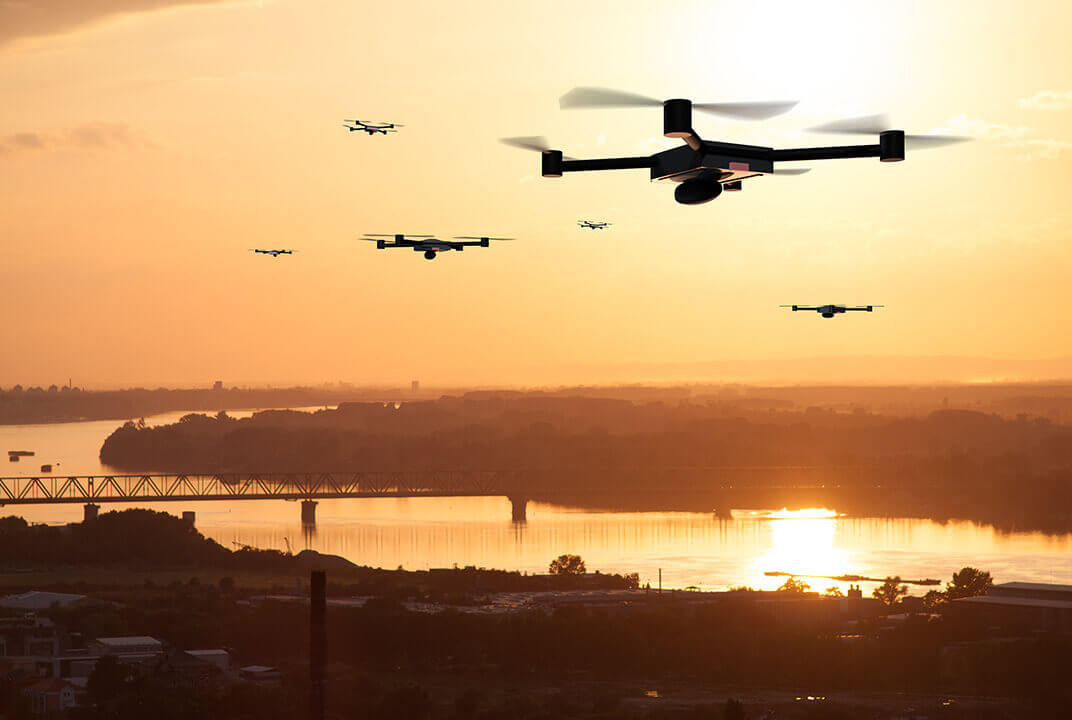Insight | Our aviation highlights of the year
Our aviation highlights of the year
null
As 2022 draws to a close, we look back at another exciting year that delivered on multiple fronts in the commercial airline, business aviation and UAV markets.
Although the aviation industry has faced unprecedented challenges due to the global pandemic, the dark clouds started to lift in 2022, bringing a renewed sense of hope and optimism. The airline and business aviation markets enjoyed consistent growth over the year and quickly adapted to the evolving needs of their passengers.
Inflight connectivity (IFC) once again played a key role in this regard, leading to record usage of our GX Aviation, European Aviation Network (EAN) and Jet ConneX (JX) services. Our operations and safety connectivity solutions also crossed a number of milestones, and we made impressive progress in the fast-growing UAV market.
Here are some of our biggest highlights for the year…
Inflight connectivity’s potential for airlines
With airlines continuing to focus on recovery, IATA reports that passenger traffic is expected to reach around 71% of pre-crisis levels in 2022. Our own 2022 Passenger Experience Survey, which questioned over 11,000 passengers around the world, showed that 83% of respondents were feeling confident about flying again - a significant rise from just 10% the previous year.
Unsurprisingly, the post-pandemic survey also found that 77% of passengers believe that inflight Wi-Fi is important to them – up from just 55% in the first survey four years ago. And with 82% of passengers globally saying they would rebook with an airline that offered quality inflight Wi-Fi, the potential for airlines was made clear.
This also reinforces the potential of a fully connected passenger journey. This year, we introduced six new bundles across our OneFi passenger engagement platform, which have created new levels of flexibility for airlines to develop an enhanced digital onboard experience for passengers. They have also unlocked new ways to monetise their inflight connectivity, focusing on elements such as loyalty, shopping and entertainment as key drivers.
The market response was fantastic and OneFi was even crowned winner in the Aviation Innovation Award 2022’s 'New Technology Innovation' category.
GX Aviation continues to fly high
An exciting development for both our current and potential customers happened when Airbus named Inmarsat as the first managed services provider on their new Airspace Link HBCplus programme. HBCPlus will see GX Aviation offered as a Supplier Furnished Equipment line-fit catalogue option for airlines to purchase, making it easier than ever for them to implement our award-winning IFC.
True to form, our GX Aviation inflight broadband solution continued to gain customers and expand across new fleets in 2022. We expanded our long-standing relationship with Qatar Airways and have begun to equip its new Boeing 787-9 and 737-10 fleet with our award-winning solution. Not to mention the work we did to help the airline offer its passengers free streaming of World Cup matches thanks to the speed and reliability of GX Aviation.
China Airlines’ first Airbus A321neo aircraft also entered commercial service with GX Aviation earlier this year and the airline continues to roll out its 25 Airbus A321neos with the service. We were also pleased to welcome new airline customer Condor onboard this year. The German airline is already starting to install GX Aviation across its long-haul fleet of 18 Airbus A330-900neos.
Celebrating the growth of EAN
AEGEAN became the latest airline to offer inflight broadband powered by our European Aviation Network (EAN) with Deutsche Telekom and confirmed plans to roll out the service across its Airbus A320 and A321 fleet.
A month later and EAN, which combines dedicated satellite coverage with a complementary LTE-based ground network, celebrated its third anniversary. During that period, it was available to more than 50 million people on over 420,000 flights with British Airways, Iberia, Vueling, and AEGEAN.
The capacity of EAN was also boosted through a partnership with Tampnet, a global provider of connectivity to offshore installations. This collaboration brought additional coverage for EAN, thanks to the installation of five EAN antenna sites on offshore production platforms in the North Sea, two antenna sites in offshore wind farms near Germany and the Netherlands, as well as one more onshore in Norway.
Improving airline operations communications
In March, Cebu Pacific Air announced that it would be integrating our SwiftBroadband-Safety (SB-S) solution with SITA’s AIRCOM cockpit services to enhance cockpit communications and deliver greater operational efficiencies on the airline’s new Airbus A330neos.
Evolution and innovation in business aviation
Business aviation turned out to be one of the industry’s most resilient markets during the pandemic, as passenger numbers remained robust. As a trusted inflight connectivity provider, we have consistently evolved our solutions to meet the increasingly sophisticated demands of business aviation passengers.
In May, we announced the launch of SwiftJet, our newest inflight connectivity service for the business aviation industry. It will enter service next year, delivering the fastest ever speeds over L-band - up to six times faster than our existing SwiftBroadband business aviation connectivity solution over L-band.
This new capacity will provide enhanced capabilities for video calls, web browsing, email, texting, cloud-syncing and collaboration tools such as Microsoft Teams. Later in the year, we announced Satcom Direct and Honeywell as the first global distribution partners for SwiftJet.
Another highlight of the year was the introduction of our JX Evolution programme, which followed an extensive assessment of passenger usage for our Jet ConneX (JX) inflight broadband solution. In response, we upgraded a number of existing service plans to deliver benefits such as increased upload rates at no additional cost, so that growing demand for high-definition video conferencing on platforms such as Microsoft Teams and Zoom is met.
The programme also resulted in the launch of JX Edge, the first in a new series of advanced, high-end service plans, which has received very positive feedback from customers.
Driving sustainability
Our work with the European Space Agency (ESA) on the Iris programme continued to develop at pace. We’re readying the service to bring about sustainability benefits in 2023, thanks to its support of the latest standards for much needed air traffic management (ATM) modernisation. This year saw easyJet become the first airline partner of the ground-breaking programme, and important new technology partnerships were also announced with Teledyne Controls and TXT Group to enhance and support work on Iris.
Our CEO Rajeev Suri also signed a contract with ESA for a new phase of the project, called Iris Global, which will focus on the technologies and certification required to share the fuel, CO2 and congestion-saving benefits of Iris with regions far beyond Europe. In addition, research on future capabilities for the integration of uncrewed aviation into European airspace will be supported.
In line with this important work, we published a whitepaper titled ‘Plotting the route to a greener future’, which explored the important role that connectivity can play in boosting the efficiency of individual flight operations and the wider air traffic system as a whole. The findings confirm that airlines can leverage satcom to maximise fuel-saving opportunities and cut emissions almost immediately, while laying the groundwork for future decarbonisation.
Improving airline operations communications
SwiftBroadband-Safety (SB-S), the service which also underpins Iris, continues to be a popular choice for airlines during fleet renewals, and now has over 220 tails using the service. The arrival of Cebu’s A330neo aircraft in March marked several firsts for Inmarsat and the industry.
It was the first aircraft in the world to fly with fully end-to-end encrypted cockpit voice and data comms, providing military grade protection to safety critical communications and operational data. Additionally, it was the first Airbus aircraft line fitted with Inmarsat Light Cockpit Satcom terminal, heralding a new era of connected aircraft rolling out of the factory fitted for future ATM requirements.
Future flight technology
Beyond the modernisation of air traffic management, future flight technologies such as all-electric and autonomous aircraft also hold the key to a more sustainable and innovative air transport industry. Inmarsat continued its work to unlock the transformational benefits of commercial uncrewed aerial vehicles (UAVs) through its Velaris beyond visual line of sight connectivity (BVLOS) service. During the year, we welcomed six exciting new partners to Inmarsat’s Velaris Partner Network - an ecosystem of leading companies pioneering new UAV innovations.
We added bandwidth crunching remote video operations with Harvest and enhanced cellular adoption for UAVs with Dimetor. In addition, have begun exploring how satellite communications will optimise the future of intra-city transportation services with Bellwether Industries, and are supporting the transformation of Lleida-Alguaire Airport into a centre of excellence for uncrewed traffic management innovation, whilst also working to improve public perception of future flight technologies with Flight Crowd. Most recently, we announced LikeAbird as our newest partner, who will integrate our miniaturised satcom terminal technology with its own products for improved weight, power and cost savings.
Adding to this future facing work, we also published a report with Cranfield University early in the year, highlighting the critical role that digital connectivity will play in accelerating aviation’s long-term recovery from the pandemic. The important report, titled ‘Why the future of aviation starts with connectivity’ offers insights and direction for key aviation stakeholders and governments as they reconsider their priorities for the industry’s future. It considers how passenger behaviour and expectations continue to change post-pandemic, as well as increased consumer awareness of their impact on the climate.
A bright future ahead
As the year draws to a close and we reflect on all that has been achieved together with our customers and partners, old and new, we look forward to a brighter future for aviation. We already know that 2023 holds much to look forward to, not least the launch of our next I-6 F2 satellite in February. With IATA’s predictions that next year will see the airline industry tip back into profitability, we look forward to achieving even bigger and better things with our partners and customers.


